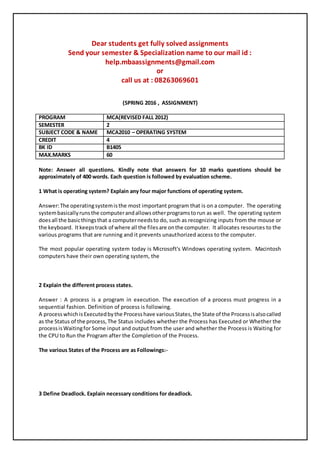
Mca2010 – operating system
- 1. Dear students get fully solved assignments Send your semester & Specialization name to our mail id : help.mbaassignments@gmail.com or call us at : 08263069601 (SPRING 2016 , ASSIGNMENT) PROGRAM MCA(REVISED FALL 2012) SEMESTER 2 SUBJECT CODE & NAME MCA2010 – OPERATING SYSTEM CREDIT 4 BK ID B1405 MAX.MARKS 60 Note: Answer all questions. Kindly note that answers for 10 marks questions should be approximately of 400 words. Each question is followed by evaluation scheme. 1 What is operating system? Explain any four major functions of operating system. Answer:The operatingsystemisthe most important program that is on a computer. The operating systembasicallyrunsthe computerandallowsotherprogramstorun as well. The operating system doesall the basicthingsthat a computerneedsto do, such as recognizing inputs from the mouse or the keyboard. Itkeepstrack of where all the filesare onthe computer. It allocates resources to the various programs that are running and it prevents unauthorized access to the computer. The most popular operating system today is Microsoft's Windows operating system. Macintosh computers have their own operating system, the 2 Explain the different process states. Answer : A process is a program in execution. The execution of a process must progress in a sequential fashion. Definition of process is following. A processwhichisExecutedbythe Processhave variousStates,the State of the Processisalsocalled as the Status of the process,The Status includes whether the Process has Executed or Whether the processisWaitingfor Some input and output from the user and whether the Process is Waiting for the CPU to Run the Program after the Completion of the Process. The various States of the Process are as Followings:- 3 Define Deadlock. Explain necessary conditions for deadlock.
- 2. Answer : A deadlock is a situation in which two computer programs sharing the same resource are effectivelypreventingeachotherfromaccessingthe resource,resultinginboth programs ceasing to function.The earliestcomputeroperatingsystemsranonlyone program at a time. Eventually some operating systems offered dynamic allocation of resources. Programs could request further allocations of resources after they had begun running. This led to the problem of the deadlock. Coffman (1971) identified four (4) conditions that must hold simultaneously for there to be a deadlock. 4. Differentiate between Sequential access and direct access methods. Answer : The hypertext and hyperlink exemplify the direct-access paradigm and are a significant improvement over the more traditional, book-based model of sequential access. (Directaccesscan also be calledrandomaccess,because itallowsequallyeasyandfastaccess to any randomlyselecteddestination.Somewhatlike travelingby a Star Trek transporter instead of driving alongthe freewayandpassingthe exitsone ata time,whichiswhatyou getwithsequentialaccess.) In a normal, physical book, the reader is supposed to read pages one by one, in the order in which theyare providedbythe author.Formost books(fiction,atleast),itmakeslittle sense forthe reader to turn directly page 256 and start reading there. 5. Differentiate between Daisy chain bus arbitration and Priority encoded bus arbitration. Answer : In most mini- and mainframe computer systems, a great deal of input and output occurs betweenthe disksystemandthe processor.Itwouldbe veryinefficienttoperformthese operations directlythroughthe processor;itismuch more efficientif such devices, which can transfer data at a veryhighrate,place the data directlyintothe memory,or take the data directly from the processor without direct intervention from the processor. I/O performed in this way is usually called direct memory access, or DMA. The controller for a device employing DMA must have the capability of generating address signals for the memory, as well as all of the memory control signals. The processor informs the DMA controller that data is 6. Explain LRU page replacement algorithm with example Answer:A goodapproximationtothe optimal algorithmisbasedonthe observation that pages that have been heavily used in the last few instructions will probably be heavily used again in the next few. Conversely, pages that have not been used for ages will probably remain unused for a long time. This idea suggests a realizable algorithm: when a page fault occurs, throw out the page that has been unused for the longest time. This strategy is called LRU (Least Recently Used) paging. Although LRU is theoretically realizable, it is not cheap
- 3. Dear students get fully solved assignments Send your semester & Specialization name to our mail id : help.mbaassignments@gmail.com or call us at : 08263069601
